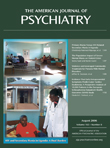Abstract
Objective: Despite well-established links between poverty and poor mental illness outcome as well as recent reports exploring racial and ethnic health disparities, little is known about the outcomes of evidence-based psychiatric treatment for poor individuals. Method: Primary care patients with panic disorder (N=232) who were participating in a randomized controlled trial comparing a cognitive behavior therapy (CBT) and pharmacotherapy intervention to usual care were divided into those patients above (N=152) and below (N=80) the poverty line. Telephone assessments at 3, 6, 9, and 12 months were used to compare the amount of evidence-based care received as well as clinical and functional outcomes. Results: Poor subjects were more severely ill at baseline, with more medical and psychiatric comorbidity. The increases in the amount of evidence-based care and reductions in clinical symptoms and disability were comparable in the two groups such that poorer individuals, although responding equivalently, continued to be more ill and disabled at 12 months. Conclusions: The comparable response of poor individuals in this study suggests that standard CBT and pharmacotherapy treatments for panic disorder do not need to be “tailored” to be effective in poor populations. However, the more severe illness both at baseline and follow-up in these poor individuals suggests that treatment programs may need to be extended in order to treat residual symptoms and disability in these patients so that they might achieve comparable levels of remission.



